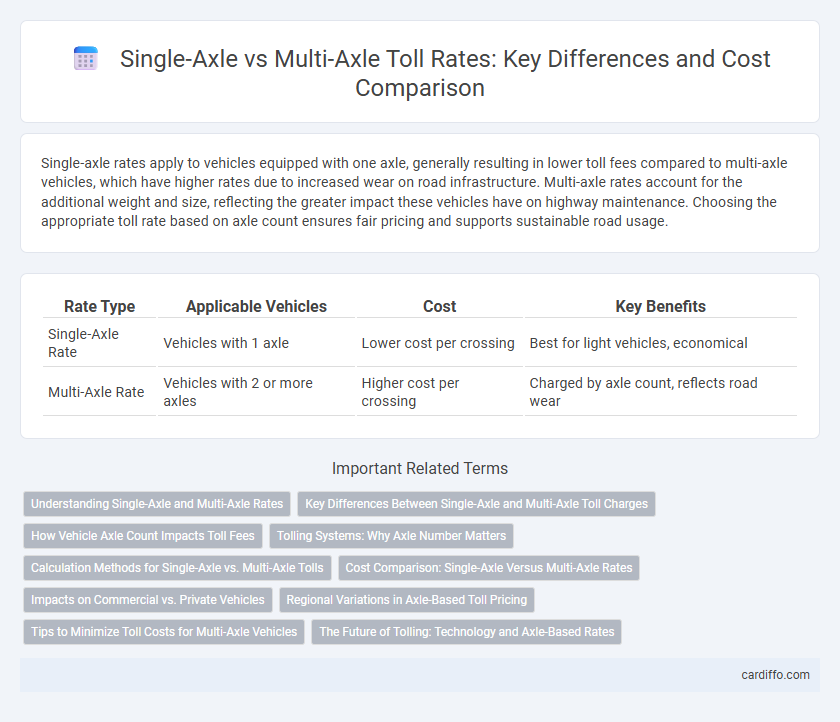Single-axle rates apply to vehicles equipped with one axle, generally resulting in lower toll fees compared to multi-axle vehicles, which have higher rates due to increased wear on road infrastructure. Multi-axle rates account for the additional weight and size, reflecting the greater impact these vehicles have on highway maintenance. Choosing the appropriate toll rate based on axle count ensures fair pricing and supports sustainable road usage.
Table of Comparison
| Rate Type | Applicable Vehicles | Cost | Key Benefits |
|---|---|---|---|
| Single-Axle Rate | Vehicles with 1 axle | Lower cost per crossing | Best for light vehicles, economical |
| Multi-Axle Rate | Vehicles with 2 or more axles | Higher cost per crossing | Charged by axle count, reflects road wear |
Understanding Single-Axle and Multi-Axle Rates
Single-axle toll rates apply to vehicles with only one axle, typically resulting in lower charges compared to multi-axle rates which are calculated for vehicles with two or more axles, reflecting the increased wear and infrastructure usage. Multi-axle rates often escalate based on the number of axles, axle spacing, and vehicle weight, affecting commercial trucks, buses, and large trailers. Understanding these rates helps drivers and fleet operators optimize route planning and budgeting for toll expenses on highways and bridges.
Key Differences Between Single-Axle and Multi-Axle Toll Charges
Single-axle toll rates are typically lower due to the reduced weight and road impact compared to multi-axle vehicles, which incur higher charges reflecting increased wear and tear on infrastructure. Multi-axle toll rates often factor in the total number of axles, vehicle weight, and size, resulting in progressive pricing that targets larger commercial trucks. This differentiation ensures fair cost distribution and maintenance funding by aligning toll fees with vehicle-induced road degradation.
How Vehicle Axle Count Impacts Toll Fees
Toll fees increase with the number of vehicle axles, as single-axle rates are significantly lower than multi-axle rates to account for greater road wear and traffic impact. Multi-axle vehicles such as trucks and buses face higher toll charges due to their increased weight distribution and potential to cause more pavement damage. This axle-based toll pricing model ensures fair cost allocation for infrastructure maintenance and traffic management.
Tolling Systems: Why Axle Number Matters
Tolling systems calculate charges based on the number of axles because each additional axle increases the wear and tear on road infrastructure and impacts traffic flow differently. Single-axle rates typically apply to standard passenger vehicles, while multi-axle rates are designed for heavier trucks and commercial vehicles, reflecting the higher maintenance costs they impose. Accurately distinguishing axle numbers ensures fair toll pricing and supports infrastructure sustainability.
Calculation Methods for Single-Axle vs. Multi-Axle Tolls
Single-axle toll rates are typically calculated based on the vehicle's weight and the toll road's set base fee, often using a flat-rate method or weight-based formulas specific to single-axle vehicles. Multi-axle toll calculations incorporate additional factors such as the number of axles, axle spacing, and vehicle classification, resulting in higher rates to account for increased road wear and infrastructure impact. Toll operators utilize dynamic pricing models and classification algorithms to accurately assess toll fees for multi-axle vehicles, ensuring equitable cost distribution and infrastructure maintenance funding.
Cost Comparison: Single-Axle Versus Multi-Axle Rates
Single-axle toll rates are typically lower than multi-axle rates due to reduced road wear and vehicle weight impacts, resulting in cost savings for drivers with lighter vehicles. Multi-axle tolls account for higher infrastructure damage and maintenance expenses, leading to increased charges proportional to the number of axles. Analyzing toll rate structures reveals that multi-axle vehicles face significantly higher fees, reflecting their greater contribution to road degradation and the need for enhanced funding to preserve transportation infrastructure.
Impacts on Commercial vs. Private Vehicles
Single-axle toll rates generally result in lower fees for private vehicles, which typically have fewer axles, whereas multi-axle rates are structured to accommodate commercial vehicles with heavier loads and more axles, leading to higher toll costs. The pricing model incentivizes commercial operators to optimize vehicle loads to balance toll expenses and cargo capacity. This axle-based toll differentiation directly impacts fleet management decisions and traffic distribution on toll roads by influencing route choices and vehicle configurations.
Regional Variations in Axle-Based Toll Pricing
Single-axle rate and multi-axle rate structures for tolls vary significantly across regions due to local infrastructure costs and traffic patterns. In North America, for example, multi-axle vehicles often face disproportionately higher tolls to account for increased road wear, while European countries may apply more moderate increments based on environmental impact assessments. Regional variations also reflect differences in vehicle classification systems and regulatory policies, influencing the overall cost burden on commercial transport operators.
Tips to Minimize Toll Costs for Multi-Axle Vehicles
Multi-axle vehicles incur higher toll rates compared to single-axle vehicles due to increased road wear and space usage. To minimize toll costs, operators can optimize routing to avoid high-toll zones, use toll accounts or transponders that offer discounts, and consider axle load distribution to stay within lower toll brackets. Strategic trip planning and adherence to toll regulations help reduce expenses for fleets operating multi-axle trucks.
The Future of Tolling: Technology and Axle-Based Rates
Future tolling systems increasingly rely on advanced axle-based rates to improve pricing equity and infrastructure funding. Single-axle rates offer simplicity but often fail to reflect actual road wear, while multi-axle rates utilize sensors and vehicle classification technologies to enable precise charge differentiation. Integration of GPS, RFID, and mobile apps enhances real-time toll collection accuracy and supports dynamic pricing models that adapt to traffic flow and vehicle impact.
Single-Axle Rate vs Multi-Axle Rate Infographic

 cardiffo.com
cardiffo.com